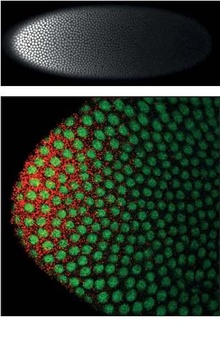| Homeotic protein bicoid | |||||||
|---|---|---|---|---|---|---|---|
| Identifiers | |||||||
| Organism | |||||||
| Symbol | bcd | ||||||
| UniProt | P09081 | ||||||
| |||||||

Homeotic protein bicoid is encoded by the bcd maternal effect gene in Drosophilia. Homeotic protein bicoid concentration gradient patterns the anterior-posterior (A-P) axis during Drosophila embryogenesis. Bicoid was the first protein demonstrated to act as a morphogen.[2] Although bicoid is important for the development of Drosophila and other higher dipterans,[3] it is absent from most other insects, where its role is accomplished by other genes.[4][5]
- ^ Little SC, Tkačik G, Kneeland TB, Wieschaus EF, Gregor T (March 2011). "The formation of the Bicoid morphogen gradient requires protein movement from anteriorly localized mRNA". PLOS Biology. 9 (3): e1000596. doi:10.1371/journal.pbio.1000596. PMC 3046954. PMID 21390295.
- ^ Driever W, Nüsslein-Volhard C (July 1988). "The bicoid protein determines position in the Drosophila embryo in a concentration-dependent manner". Cell. 54 (1): 95–104. doi:10.1016/0092-8674(88)90183-3. PMID 3383245. S2CID 18830552.
- ^ Gregor T, McGregor AP, Wieschaus EF (April 2008). "Shape and function of the Bicoid morphogen gradient in dipteran species with different sized embryos". Developmental Biology. 316 (2): 350–358. doi:10.1016/j.ydbio.2008.01.039. PMC 2441567. PMID 18328473.
- ^ Chouard T (November 2008). "Darwin 200: Beneath the surface". Nature. 456 (7220): 300–303. doi:10.1038/456300a. PMID 19020592.
- ^ Schröder R (April 2003). "The genes orthodenticle and hunchback substitute for bicoid in the beetle Tribolium". Nature. 422 (6932): 621–625. Bibcode:2003Natur.422..621S. doi:10.1038/nature01536. PMID 12687002. S2CID 4406927.